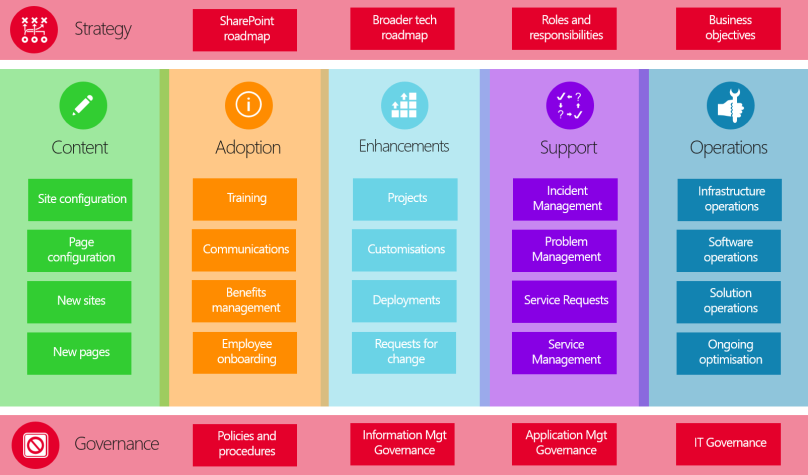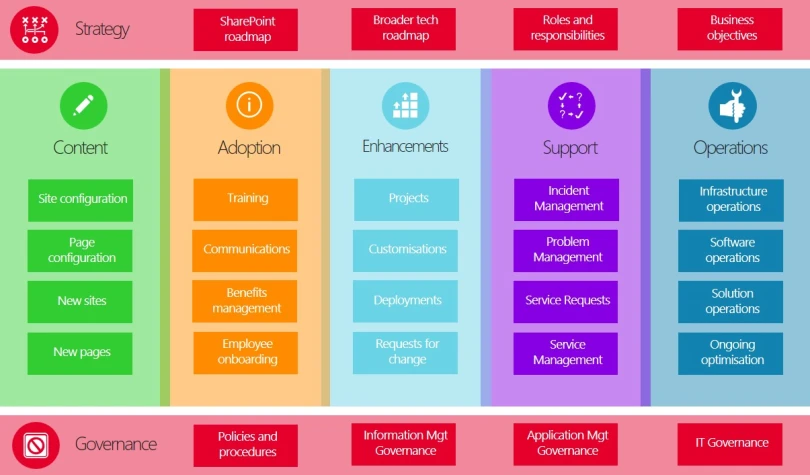Introduction
Most SharePoint projects focus on building the solution. This covers the information architecture, user experience, interface design, apps/add-ins, and system integrations that come together to form an effective SharePoint implementation. Fewer still define an effective strategy and business change approach for the project. But – in my experience at least – hardly any projects give much heed to how to run SharePoint once it goes live in the organisation. Having a well-defined Operating Model is crucial to ensuring the on-going success of the platform and can help to ease the difficult transition from project into service.
What is an “Operating Model”?
“An Operating Model is the organisational design that makes it possible to deliver the business strategy”. – Ashridge Business School
My interpretation of an Operating Model is that it’s a set of guidelines for how SharePoint aligns with people, processes and other technology to deliver the business strategy. The Operating Model defines the necessary level of process integration and standardisation to allow your SharePoint service to thrive and grow. It provides a general vision of how your organisation will enable the long-term business benefits of the platform. It drives the foundation for executing the SharePoint strategy.
I’ve also heard it described as “governance on steroids” in that it provides some definition to roles, responsibilities, processes and procedures. However, governance typically focuses on information management, application management, and IT ops. This is necessary work that all organisations looking to use SharePoint should be doing, yet SharePoint often requires something more holistic to get the most out of it long-term. This is where the Operating Model comes in.
There are two overriding dimensions that drive an operating model. These are:
- Standardisation; and
- Integration.
Standardisation is about defining how a process will be executed so that it runs smoothly no matter who is enacting it. This delivers efficiency and predictability around who is doing what, and helps align the platform across different divisions in the company, as well as third party suppliers.
Integration is about linking efforts through shared data, capability and knowledge. It ensures that new capabilities or initiatives delivered in SharePoint can be smoothly integrated with the pre-existing functionality.
A Sample Operating Model
The diagram below shows a sample high-level Operating Model:

The thinking behind this model is to divide SharePoint into five operational pillars: Content, Adoption, Enhancements, Support, and Operations. An overarching strategy supplements these pillars, and governance policies and processes underpin them.
 |
Strategy defines the direction for the platform. It ensures everyone involved in operating the system is singing from the same hymn sheet and pushing for the same outcomes. It provides direction and impetus for action and helps to guide future investments in the platform. |
 |
Content encompasses all information stored on the platform. It covers the configuration possible without formal change control or lifecycle management. |
 |
Adoption covers the on-going training, communications and business change aspects of running SharePoint. It ensures employees engage with and use the platform. |
 |
Enhancements is how to deal with change in the system. This could range from adding small features to much bigger, strategic programmes of work. |
 |
Support is all about how incidents, problems and service requests get raised against the system. It also covers who deals with them, and how to categorise and prioritise them. |
 |
Operations covers on-going maintenance tasks. These activities ensure the smooth running and optimisation of the system over time. You will typically find that on-premises implementations will be much heavier from an ops perspective. This is because you have little control over much of the IT operational tasks in SharePoint Online, as Microsoft looks after these for you. |
 |
Governance underpins the core operational pillars. It fleshes out the policies and procedures that must be followed to run SharePoint. |
Together, these elements form a holistic Operating Model that can deliver standardisation and integration across the different pillars, and ensure that SharePoint can thrive within an organisation.
This series
I’m going to write a series of blog posts focusing on defining an operating model for SharePoint. I’ll do one post for each of the 5 operational pillars, plus one each for strategy and governance. I’ll also do an extra post on organisation design, and how to put together the right teams, roles and responsibilities to run SharePoint. I hope this blog series will provide some useful reference material for organisations who want to maximise their return on investment with SharePoint.
Thanks for reading.
—————————————————————
Part 1 – Introducing the SharePoint Operating Model

